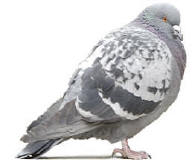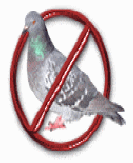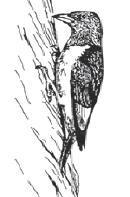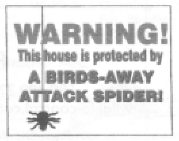 |
|
 |
||||||
|
Home - About Us - Services - Birds - Bees - Wildlife - Products - Projects - Faq - PMP - Help - Links - Contact Us |
||||||||
|
Height/Weight Life Span Flight Speed Range Habitat
|
Pigeon Sparrow Swallow Starling Woodpecker Crow Grackles
Woodpecker Control, Biology and General Information
Pecking or “drumming” against trees or buildings is the characteristic most associated with Woodpeckers. They do this to establish territories and to attract or signal mates. Woodpeckers primarily feed on tree living or wood-boring insects using their strong beak and long tongue to dislodge food. Some members of the Woodpecker family (Flickers) feed on insects of the ground, while others prefer native berries, fruit and nuts. Arizona has what is called a "Gila Woodpeckers" and they are protected by law from shooting or trapping without a special permit from the Fish & Game Department. Woodpeckers (Melanerpes spp.), including sapsuckers (Sphyrapucys spp.), and flickers (Colaptes spp.) belong to an interesting and well-known group of birds in the family Picidae. There are 17 species found in California, two of which are California-listed endangered species. Woodpeckers vary in size and range from about 7 to 14 inches in length, usually with brightly contrasting coloration. Most males have some red on the head, and black and white markings are common on many species. They have short legs with two sharp-clawed backward pointed toes and stiff tail feathers that serve as a support prop. Such physical traits permit them to cling easily to trees or wood surfaces. They have stout, sharply pointed beaks and a long tongue for extracting larvae and other insects from wood crevices. Because they are dependent on trees for shelter and food, woodpeckers are commonly found within or on the fringes of wooded or forested areas. BIOLOGY AND BEHAVIORWoodpeckers come into conflict with people when they use human dwellings in their search of food, or as a surface for territorial/social drumming, or for nest construction. Such activities not only create disturbing noises but, more significantly, may cause structural damage. Pecking damage can occur on wooden siding, eaves, or trim boards. Cedar and redwood siding seem most vulnerable, especially rough-hewn veneer-type plywood. Reverse board-and-batten veneer plywood is especially prone because of gaps created as a result of the manufacturing process. These gaps provide hidden spaces that harbor insects, which in turn, attract woodpeckers in search of food. When searching for insects, woodpeckers leave a series of small holes all in a row, which is characteristic damage. Woodpeckers will also peck larger holes in wood siding to create nests in the wall cavity. Exploratory pecking is commonplace. The damage tends to be on houses in or near natural wooded areas and most often occurs in suburban or rural settings. Part of a woodpecker's breeding behavior is an incessant rhythmic tapping or repetitive drumming on wood or other hard surfaces using the bill as a way of proclaiming breeding territory and social significance. Woodpeckers prefer drumming surfaces that resonate loudly. They frequently bypass wood and use metal gutters and downspouts, television antennae, or metal rooftop ventilators. Both male and female woodpeckers drum. This activity may be annoying to household residents, especially if it starts in the early morning hours. Gardeners and landscapers are sometimes confronted with a series of small holes in rows pecked through the bark of a tree trunk or tree limb by a sapsucker seeking food. Over time, this continuous activity extends the number of rows of holes and the resulting loss of sap may weaken the tree and provide access for harmful insects or plant diseases. Some species of woodpeckers feed on fruits, berries, and nuts, but crop damage rarely constitutes a significant problem. LEGAL STATUSAll woodpeckers are protected under the Migratory Bird Treaty Act of 1918 as migratory insectivorous birds and are classified as non-game by the state. Two California woodpeckers (Gila woodpecker, Melanerpes uropygialis, and Gilded northern flicker, Colaptes auratus chrysoides) are California-listed endangered species and are offered greater protection. When warranted, woodpeckers other than endangered species can be killed, but only under a permit issued by the Law Enforcement Division of the U.S. Fish and Wildlife Service upon recommendation of the United States Department of Agriculture, Animal and Plant Health Inspection Service (USDA-APHIS) Wildlife Services personnel. Generally there must be a good case to justify a permit and the permit process is time consuming. Control methods that do not harm the bird or its active nest are allowed except for the two endangered species. Those species cannot be harassed or bothered in any way. Physical exclusion, if installed before the endangered species is in the area, is allowed. For more information on these and other endangered species, see the California Department of Fish and Game Web site, or contact the main office of USDA-APHIS Wildlife Services in your state. MANAGEMENT
Installing bird-type netting to prevent woodpeckers from gaining access to wood siding or other wood surfaces is the most effective method to stop building damage. The lightweight netting in 3/4-inch mesh is stretched from the eaves to a lower point on the building. Alternatively, the netting can be stretched over any flat surface subject to damage, leaving at least three inches of space between the netting and damaged surface so that the birds cannot cause further damage through the mesh. If the appropriate type and color of netting is selected and properly installed, it is barely visible from a distance of a few yards and will offer a long-term solution to prevent subsequent damage. Remember that you may have to net the entire side of a building; otherwise the woodpecker may move just beyond the netted area and continue its activities. If a homeowner installs a plastic net, it should be attached so that so that it can be pulled taut. This prevents flapping in the wind, which looks unsightly and results in tangles or breakage at mounting points. The net should not have any loose pockets or wrinkles that could trap and entangle birds. Netting can be attached using tape, staples, or hooks on the eaves and the side of the building. An advantage of hooks is that the net can be taken down for maintenance of light fixtures, painting, etc. If staples are used, they should be rust-resistant to avoid unsightly rust stains on the building. When using hooks, a supporting framework of wooden dowels, wood laths, or metal rods along the netting edges will ease attachment and create uniform tension on the net. Netting may also be wrapped once or twice around wood laths and nailed directly to the building. It should extend from the outer eaves edge down the side of the building to the point where the eaves' protection from the elements is lost. Extensive netting may be a bigger task than some homeowners want to assume, especially if it involves a two-story building. In this case, it may be advisable to call a Arizona Wings N' Stings a bird control professional. Netting is increasingly used to curtail woodpecker damage because it consistently provides the desired result. Sections of lightweight sheet metal or 1/4-inch hardware cloth may be fastened directly over the woodpecker-damaged areas. If done at the first sign of damage the bird may be discouraged and move on to another location. This metal sheeting or wire mesh can be painted to match the siding. This method is most useful where only one or a few relatively small areas have been damaged. Wire mesh, such as chicken wire, wrapped around tree trunks or limbs being damaged by a sapsucker will often persuade the bird to relocate. In most cases, it will be necessary to protect a large area with mesh because the woodpecker will move to a nearby area and begin pecking again. Bird netting is available at many hardware and farm supply stores as well as from Internet sources. Frightening Devices
RepellentsMany chemicals having objectionable tastes or odors have been tested for repelling woodpeckers with little or no success. This search continues and in the future something effective may be found. On buildings sticky or tacky bird repellents such as Tangle foot are sometimes effective if applied to sections of thin plywood and placed over the damaged area. The substances do not entrap the birds, but they dislike the tacky footing. Applying sticky or tacky bird repellents can sometimes be an effective solution to the problem of sapsucker attacks on trees. Other Control MethodsOther methods that are sometimes suggested include feeding suet to the woodpecker in the hope of discouraging damage. Placing nest boxes on nearby buildings, poles, or trees has also been advised. However, research shows that placing food or nesting boxes in the area does not consistently reduce the problem. These methods may, in fact, attract more woodpeckers. Acknowlegement:
|
|||||||
|
Copyright © 2009 Arizona Wings-N-Stings All rights reserved. Revised: 02/01/10. |
||||||||
| Website by JAK | ||||||||


 There are over 200 different species of woodpeckers worldwide, 23 of which
can be found in the United States. The woodpecker is most commonly found in
wooded regions of the country, where they can cause damage to the exterior
of wooden buildings and houses. The Woodpecker’s unique body is designed to
easily cling to tree trunks, branches, wood siding, or utility poles while
pecking for food.
There are over 200 different species of woodpeckers worldwide, 23 of which
can be found in the United States. The woodpecker is most commonly found in
wooded regions of the country, where they can cause damage to the exterior
of wooden buildings and houses. The Woodpecker’s unique body is designed to
easily cling to tree trunks, branches, wood siding, or utility poles while
pecking for food.  Several methods have been used to prevent damage or to
frighten woodpeckers from a site. Physical exclusion is by far the most
effective. More often than not, frightening devices, sonic devices or repellents fail to
provide the desired result.
Several methods have been used to prevent damage or to
frighten woodpeckers from a site. Physical exclusion is by far the most
effective. More often than not, frightening devices, sonic devices or repellents fail to
provide the desired result.  Models of hawks, owls, and snakes are ineffective as
frightening devices. Plastic twirlers or windmills fastened to the eaves,
and aluminum foil or brightly colored plastic strips hung from above repel
by movement and reflection and have been used with inconsistent degrees of success.
Various other gadgets or devices are marketed for frightening woodpeckers,
including a sound-activated giant model of a climbing spider. Some claim
that various frightening devices resolved their particular problem. This is
possible only if the woodpecker has not become well-attached to that
particular location. Once established, woodpeckers are persistent and are
not easily driven from their territory or selected pecking site.
Models of hawks, owls, and snakes are ineffective as
frightening devices. Plastic twirlers or windmills fastened to the eaves,
and aluminum foil or brightly colored plastic strips hung from above repel
by movement and reflection and have been used with inconsistent degrees of success.
Various other gadgets or devices are marketed for frightening woodpeckers,
including a sound-activated giant model of a climbing spider. Some claim
that various frightening devices resolved their particular problem. This is
possible only if the woodpecker has not become well-attached to that
particular location. Once established, woodpeckers are persistent and are
not easily driven from their territory or selected pecking site.